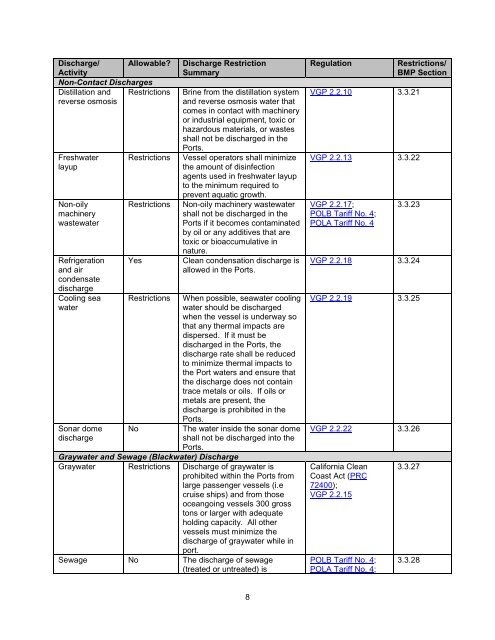Vessel Discharge Rules and Regulations - The Port of Los Angeles
Vessel Discharge Rules and Regulations - The Port of Los Angeles
Vessel Discharge Rules and Regulations - The Port of Los Angeles
Create successful ePaper yourself
Turn your PDF publications into a flip-book with our unique Google optimized e-Paper software.
<strong>Discharge</strong>/ Allowable? <strong>Discharge</strong> Restriction<br />
Regulation Restrictions/<br />
Activity<br />
Summary<br />
BMP Section<br />
Non-Contact <strong>Discharge</strong>s<br />
Distillation <strong>and</strong> Restrictions Brine from the distillation system VGP 2.2.10 3.3.21<br />
reverse osmosis<br />
<strong>and</strong> reverse osmosis water that<br />
comes in contact with machinery<br />
or industrial equipment, toxic or<br />
hazardous materials, or wastes<br />
shall not be discharged in the<br />
<strong>Port</strong>s.<br />
Freshwater Restrictions <strong>Vessel</strong> operators shall minimize VGP 2.2.13 3.3.22<br />
layup<br />
the amount <strong>of</strong> disinfection<br />
agents used in freshwater layup<br />
to the minimum required to<br />
prevent aquatic growth.<br />
Non-oily Restrictions Non-oily machinery wastewater VGP 2.2.17;<br />
3.3.23<br />
machinery<br />
shall not be discharged in the POLB Tariff No. 4;<br />
wastewater<br />
<strong>Port</strong>s if it becomes contaminated<br />
by oil or any additives that are<br />
toxic or bioaccumulative in<br />
nature.<br />
POLA Tariff No. 4<br />
Refrigeration Yes Clean condensation discharge is VGP 2.2.18 3.3.24<br />
<strong>and</strong> air<br />
condensate<br />
discharge<br />
allowed in the <strong>Port</strong>s.<br />
Cooling sea Restrictions When possible, seawater cooling VGP 2.2.19 3.3.25<br />
water<br />
water should be discharged<br />
when the vessel is underway so<br />
that any thermal impacts are<br />
dispersed. If it must be<br />
discharged in the <strong>Port</strong>s, the<br />
discharge rate shall be reduced<br />
to minimize thermal impacts to<br />
the <strong>Port</strong> waters <strong>and</strong> ensure that<br />
the discharge does not contain<br />
trace metals or oils. If oils or<br />
metals are present, the<br />
discharge is prohibited in the<br />
<strong>Port</strong>s.<br />
Sonar dome No <strong>The</strong> water inside the sonar dome VGP 2.2.22 3.3.26<br />
discharge<br />
shall not be discharged into the<br />
<strong>Port</strong>s.<br />
Graywater <strong>and</strong> Sewage (Blackwater) <strong>Discharge</strong><br />
Graywater Restrictions <strong>Discharge</strong> <strong>of</strong> graywater is California Clean 3.3.27<br />
prohibited within the <strong>Port</strong>s from Coast Act (PRC<br />
large passenger vessels (i.e 72400);<br />
cruise ships) <strong>and</strong> from those<br />
oceangoing vessels 300 gross<br />
tons or larger with adequate<br />
holding capacity. All other<br />
vessels must minimize the<br />
discharge <strong>of</strong> graywater while in<br />
port.<br />
VGP 2.2.15<br />
Sewage No <strong>The</strong> discharge <strong>of</strong> sewage POLB Tariff No. 4; 3.3.28<br />
(treated or untreated) is<br />
POLA Tariff No. 4;<br />
8

















